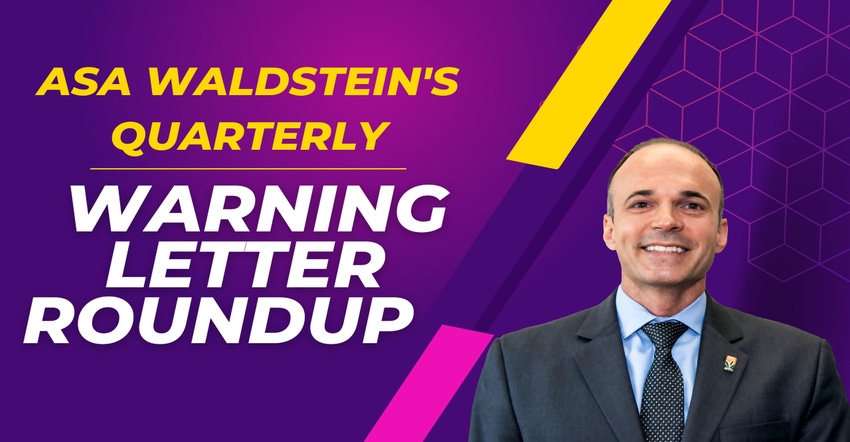In his quarterly update, consultant Asa Waldstein identifies trends in FDA warning letters impacting manufacturers and marketers of dietary supplements.
December 20, 2022

Each quarter, I provide updates on notable FDA warning letters. Understanding enforcement trends is essential for being a savvy marketer, regulatory affairs professional and dietary supplement executive. Have you wondered why FDA issues warning letters to certain companies and not others? FDA likes to make examples of companies not following the rules in areas they want to focus on, many of which I review here. Staying ahead of trouble is one of the critical and fun reasons to follow enforcement trends.
My 2023 enforcement predictions:
- Continued enforcement of biomarker claims related to blood sugar and heart disease (e.g., lowers A1C);
- A continued increase in CBD warning letters, especially for those containing delta-8;
- Enforcement of TikTok disease claims and FTC crackdown on influencers not disclosing a material connection;
- FDA crackdown for claims made on affiliate and distributor websites.
Key trends:
Saying “thanks” on a social media post: It has been a couple of years since FDA has cited a company for “liking” posts with disease claims on their social media wall. This recent letter cites a company for “liking” and also for “saying thanks” to customer posts. FDA’s position is that any engagement is considered “endorsing the testimonial.” I suggest fighting the urge to engage with social media posts and product reviews containing disease language. This includes old posts, which are considered active marketing, and now is an excellent time to review those “forgotten” old posts to ensure there is nothing that can elevate your warning letter risk.
Biomarkers claims: Claims about heart disease prevention are always a high risk, but the recent cardiovascular warning letters signal a shift in FDA’s thinking. Several of these letters cite biomarker claims like “lowers LDLs.” In the past, these types of claims have been mentioned in warning letters when higher-risk words such as “hypertension” are present, but some of these recent letters only cite mid-risk claims such as “lowers bad fats,” “lowers LDLs” and “lowers cholesterol.” This shows FDA’s position that even implying a product can be used for heart disease can lead to a warning letter.
Amazon and Walmart: These companies were issued warning letters for selling an omega-3 product adulterated with an undeclared NSAID (non-steroidal anti-inflammatory drug) similar to aspirin. They were also cited for using the disease claim “arthritis.” This is the most common “itis” referenced in warning letters and should always be avoided. Dietary supplement regulations require distributors to follow specific cGMP (current good manufacturing practices) rules, and I am surprised it took this long for Amazon and Walmart to be cited. I expect Amazon to implement more rigid testing requirements and start flagging products with even mid-risk disease claims. FDA also continues to issue warning letters to brands for making claims on these platforms, which is an enforcement trend to watch. Companies may have a robust website and social media compliance review system, but they often overlook claims on platforms like Amazon and Walmart. I expect many more Amazon- and Walmart-related warning letters.
Brain fog: A letter from October is the second mention of “brain fog” in an FDA warning letter. According to the U.S. Department of Health and Human Services, “brain fog” can be a symptom of long-haul Covid, a recognized disability under the Americans with Disabilities Act. “Brain fog” related to Covid symptoms is a disease claim, but “occasional brain fog” not associated with a disease seems low on the agency’s priority list. Due to the hashtags in this post, the correlation to Covid is undeniable. This is a good reminder that hashtags can be considered disease claims and tip the scale into the warning letter category.
From the FDA warning letter: “Plants geared towards cardiac and mental health, brain fog, respiratory issues, and fatigue … #postcovid, #postcovidsyndrome, #longcovidrecovery, #longcovidsymptoms”
Additional trends to keep a close eye on are:
Small companies are on FDA’s radar: There is a common misconception that some companies are “too small to be on FDA’s radar.” Several recent letters have been sent to small companies selling online, such as cottage industry producers. Companies new to supplement marketing should have a basic understanding of the rules, many of which I have discussed in my regulatory videos, and Q1, Q2 and Q3 warning letter roundups.
Product tags and meta tags: These continue to be cited in warning letters. These tags help people find products when they search on Google or a website, and they are considered marketing in the eyes of the authorities. Although these tags are an “extension of the label,” they are not likely to attract a warning letter on their own, but they do signal intended use, which can lead authorities to a commercial website to keep digging for claims once there.
CBD update: There have been 34 CBD-related FDA warning letters this year, a 485% increase over last year. Here are some key takeaways.
- Pretty much every warning letter includes disease claims. However, this letter is a rare exception. FDA cited the company for selling a caffeine-containing ingredient in a CBD beverage, which signals a shift in FDA’s enforcement thinking. FDA is concerned with the risks that CBD poses on caffeine metabolism. If you sell CBD and caffeine products, I would remove them from the market ASAP.
- 40% of this year’s letters mention animal products, and animal and CBD product claims seem to be scrutinized more than human products. For example, an "anxious feelings" claim is not likely to attract a human CBD warning letter, but it may be enough for an animal CBD letter.
- Some recent letters involve CBD in food products such as lollipops, cookies and infused sugar. This is a problem for FDA because these food formats are favorable to children who may consume too much CBD, resulting in a possible health concern. These are not form factors used in the supplement industry; they seem unnecessary and poor formats for delivering CBD.
- CBD in over-the-counter (OTC) drugs is very risky, and FDA is intolerant of CBD listed as an active or an inactive ingredient. This recent letter cited a well-known company for adding CBD as an active sunscreen ingredient.
Follow Warning Letter Wednesday for weekly updates on interesting warning letters.
Asa Waldstein is a certified clinical herbalist and a 20-year dietary supplement executive who has helped oversee three FDA inspections with no 483s. Waldstein is principal of the consulting company Supplement Advisory Group, a boutique group focusing on marketing risk analysis and practical marketing solutions for the web and social media. He is the founder and host of Asa's Regulatory Education Series, a free educational platform focusing on GMP compliance, enforcement trends, and marketing tips for the supplement and hemp industries. He also chairs the American Herbal Products Association's (AHPA) Cannabis Committee and is a Naturally Boulder board member. This article is informational only and is not intended to replace competent legal or regulatory review. Learn more and contact him at AsaWaldstein.com.
About the Author(s)
You May Also Like






.png?width=800&auto=webp&quality=80&disable=upscale)